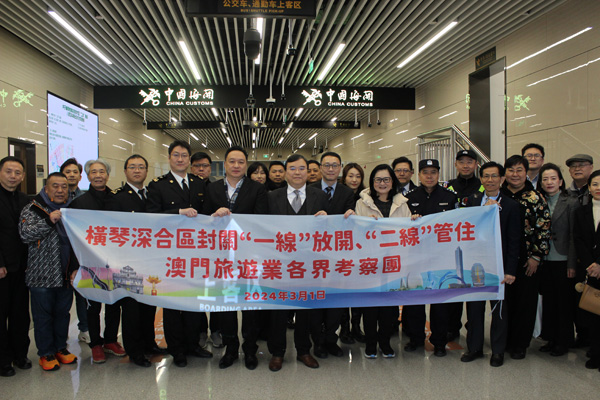GBA cities forging closer ties to bolster mutual benefits
Driving comprehensive cooperation between Guangdong province and the Hong Kong and Macao special administrative regions, the Guangdong-Macao In-Depth Cooperation Zone in Hengqin, Guangdong province, began closed-loop operation on March 1, applying preferential tax and customs policies. It marked the region's high-level integration with Macao.
A "first-tier" customs-supervised zone has been set between Hengqin and Macao, while "second-tier" customs-supervised areas are being established between Hengqin and other areas within the Chinese mainland. Goods meeting the conditions and entering the cooperation zone through the "first tier" are exempt from import tariffs, import value-added tax and consumption tax. But items entering the Chinese mainland through the "second tier", if exceeding the 8,000 yuan ($1,111) quota, will be subject to taxes.
Macao residents studying, working, starting businesses or living in the cooperation zone can bring in cooked meat, dairy products, vegetables, fruits and other items through the "first-tier" customs.
Wang Fuqiang, director of the department of industrial planning at the China Center for International Economic Exchanges, said the initiative will promote the efficient and convenient flow of logistics, people, funds and information between Hengqin and Macao; help the cooperation zone accelerate its construction as a new platform to promote Macao's moderately diversified economic development; a new space to assist the lives and employment of Macao residents; a new demonstration zone enriching the practice of "one country, two systems"; and a new highland for promoting the construction of the Guangdong-Hong Kong-Macao Greater Bay Area.

Representatives from Macao's tourism industry pose for a photo during their visit to the Guangdong-Macao In-Depth Cooperation Zone in Hengqin, Guangdong province. CHINA DAILY
On Jan 23, the Guangdong provincial government work report proposed accelerating the construction of a world-class Bay Area. The closed-loop operation of the Guangdong-Macao In-Depth Cooperation Zone in Hengqin is one of the measures to achieve this goal.
Others include the revision of regulations for the Shenzhen Qianhai Cooperation Zone; creating multiple industrial agglomeration areas; formulating and implementing a new overall development plan for Nansha; and the formulation of regulations for the Development Plan for Shenzhen Park's Hetao Shenzhen-Hong Kong Science and Technology Innovation Cooperation Zone.
The work report also pointed out that Guangdong aims to establish itself as a strategic fulcrum for the country's new development pattern, build innovation highlands in industries such as 5G, integrated circuits, nanotechnology and biomedicine and a leader of the Chinese-style modernization.
This year marks the fifth anniversary of the release of the outline development plan for the Bay Area.
Currently, the Bay Area has eight industrial clusters with the value of each exceeding 1 trillion yuan, including next-generation electronic information, green petrochemicals, smart home appliances and automobiles, as well as emerging industries such as new energy vehicles, new energy storage and solar photovoltaics. The economic output of the Bay Area reached about 13.6 trillion yuan in 2023.
Gong Guoping, director of the Guangdong Provincial Department of Science and Technology, said that joining the ranks of the world's top sci-tech clusters relies on the ecosystem of "basic research, technological innovation, research results commercialization, sci-tech finance and talent support" in the Bay Area.
Zhu Wei, deputy director of the Guangdong Provincial Development and Reform Commission, said that over the past five years, the Bay Area has been catching up.
The Bay Area has initially built a cluster of major scientific and technological infrastructure supporting research in fields such as information, biology and materials.
The trend of industry-led and high-tech enterprises innovating together is becoming increasingly prominent in the Bay Area, Zhu said.



 Print
Print Mail
Mail

